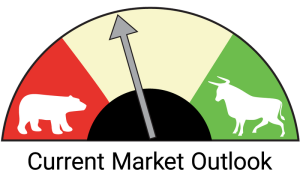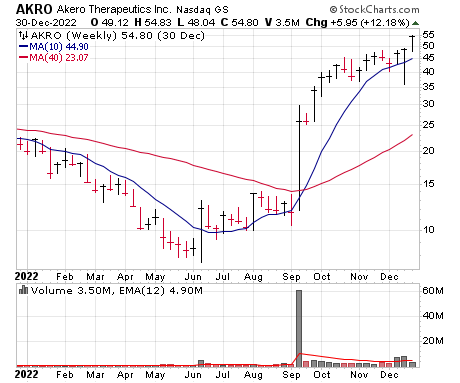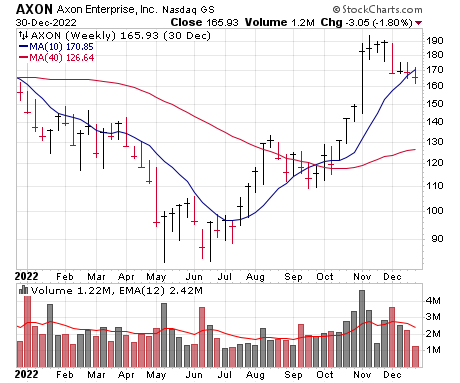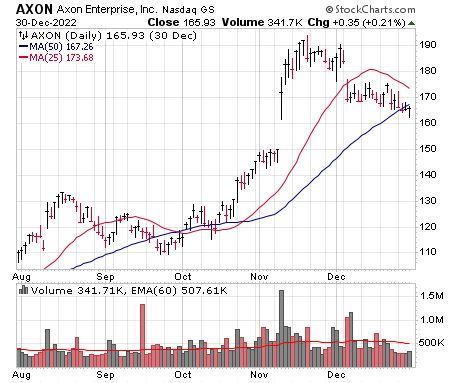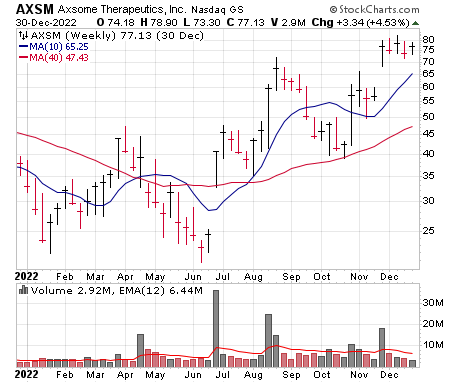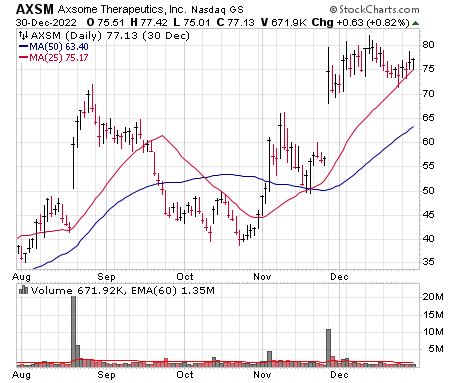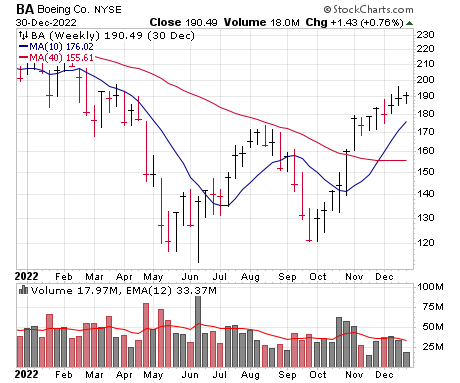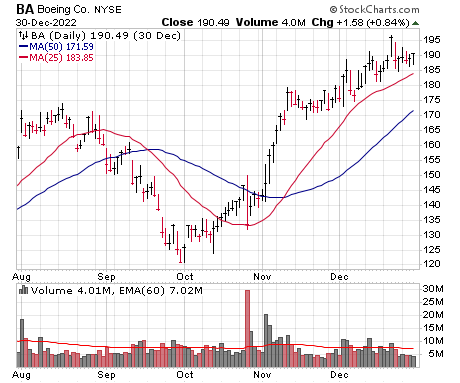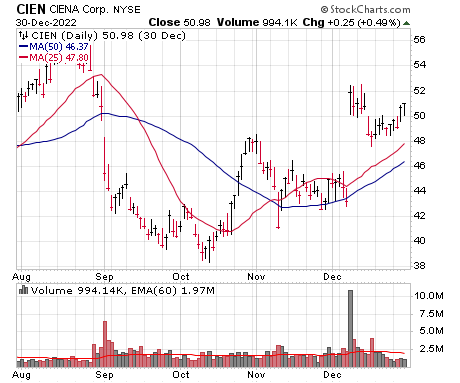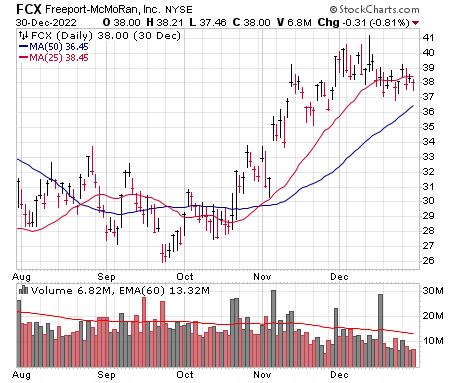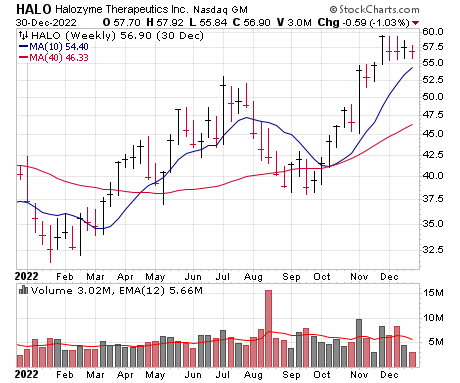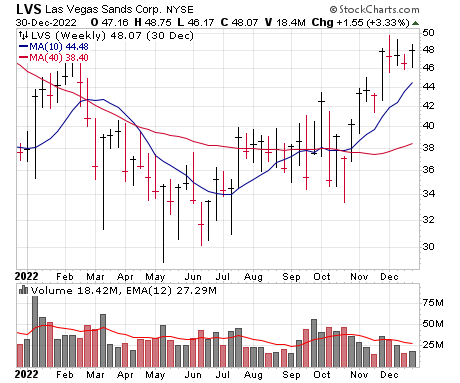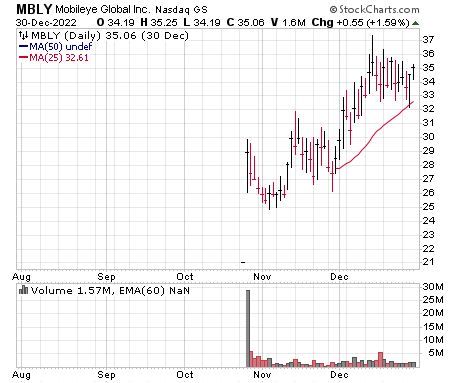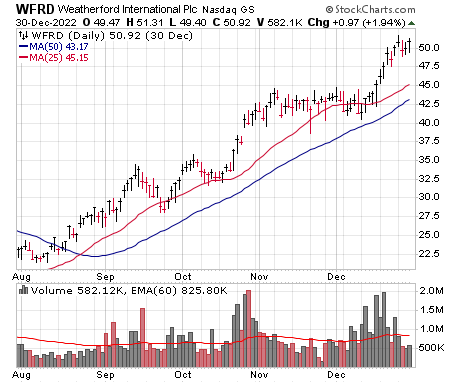The Onus Remains on the Bulls
The calendar has flipped, but nothing has changed with the evidence during the past couple of weeks—the intermediate-term trend, which was stubbornly up for a while, has given way, joining the long-term trend on the downside, all while growth stocks underperform (they usually do the opposite in healthy environments). That said, most indexes and sectors are doing more chopping than plunging, especially when looking at the broad market (not just growth) as things try to bottom out after last year’s selling. It’s important to remain open to anything—remember that the market is looking six months ahead, so if/when it starts to see improving vibes, it can turn up in a hurry—but, simply put, the onus clearly remains on the bulls to step up and take control of more stocks, sectors and indexes. Our Market Monitor remains at a level 4, though if weakness spreads, we’ll pare back further.
Our first list of the New Year casts a wide net, and includes a variety of themes and sectors. Our Top Pick is Las Vegas Sands (LVS), which we think can be a powerful turnaround play and provide exposure to the improving non-U.S. area of the market.
| Price |
Stock 1
Akero Therapeutics (AKRO)
Price | Buy Range | Loss Limit |
Why the Strength
Akero, a clinical-stage cardio-metabolic biotech, is leading the way to find a treatment for non-alcoholic steatohepatitis (NASH)—an advanced form of fatty liver disease that can be caused by underlying conditions like obesity, metabolic syndrome or type 2 diabetes. This potentially fatal disease is without any approved therapies, but Akero’s lead drug candidate, the genetically engineered fusion protein Efruxifermin (also known as Efru), is designed to mimic the protein fibroblast growth factor 21 (FGF21) in order to reduce the accumulation of fat and fibrotic tissue in the liver in NASH patients. Efru is currently being evaluated in a Phase 2B clinical trial, known as Harmony, as a potential treatment for NASH, and recent trials have shown promise (a big reason for the strength). In September, the Harmony trial reached its main goal, giving the stock a big boost; the latest strength came last month when the FDA granted Efru a breakthrough therapy designation for treating NASH. (A post-Phase 2 meeting is scheduled for March to review additional Harmony data and a proposed Phase 3 clinical program.) On the new product front, Akero just manufactured a new drug delivery device combination for use in Phase 3 clinical trials designed for convenient patient self-administration. The current numbers are basically meaningless, as Q3 saw no sales and a 92-cent EPS loss. But cash holdings at the end of Q3 were $374 million (bolstered by a September share offering), which the company said will fund operating plans well into 2025 (obviously good in terms of less potential dilution going ahead). Management also believes the Efru results to date contribute to a “growing body of evidence” that the drug, if approved, has the potential to be both a “foundational monotherapy” for the treatment of NASH and a blockbuster for Akero.
Technical Analysis
After hitting a major, multi-year low back in June at 8, AKRO spent the next three months building a base that served as the launching pad for the September blast-off that followed the trial results—and the stock kept going after the initial gap, rising to the upper 40s by Thanksgiving. The shakeout that followed was super-sharp but was a one-day event, and AKRO has soared to new highs since. Aiming for further weakness after today’s should be your best bet if you want in.
| Market Cap | $2.56B | EPS $ Annual (Dec) | ||
| Forward P/E | N/A | FY 2020 | -2.52 | |
| Current P/E | N/A | FY 2021 | -2.89 | |
| Annual Revenue | Nil | FY 2022e | -3.20 | |
| Profit Margin | N/A | FY 2023e | -3.50 | |
| Qtrly Rev | Qtrly Rev Growth | Qtrly EPS | Qtrly EPS Growth | |
| ($M) | (vs. yr-ago-qtr) | ($) | (vs. yr-ago-qtr) | |
| Latest qtr | Nil | N/A | -0.92 | N/A |
| One qtr ago | Nil | N/A | -0.77 | N/A |
| Two qtrs ago | Nil | N/A | -0.74 | N/A |
| Three qtrs ago | Nil | N/A | -0.93 | N/A |
Weekly Chart | Daily Chart |
Stock 2
Axon Enterprises (AXON)
Price | Buy Range | Loss Limit |
Why the Strength
As we roll into 2023, Axon Enterprises has the story, numbers and chart to be a leader going forward, especially should the market kick into gear. Axon’s claim to fame used to be its Taser stun guns, which save lives by replacing bullets, and that’s still about 45% of the business and growing nicely (up 19% from a year ago)—but the real excitement is how Axon has expanded its opportunity by moving into cameras (body and in-car; it even has drones) and the cloud, where it offers evidence and fleet/dispatch management solutions; all in, the firm claims its offerings result in 20% more guilty pleas and 70% less court time for officers, too. Best of all is that Axon now sells most of its offerings on a subscription basis (that includes many Tasers, with packages that include virtual reality training; all in all, 80% of Axon’s revenues come from some sort of subscription), leading to a long runway of higher recurring revenue—and even with its growth of late, Axon thinks it has tons of whitespace in the U.S. and overseas, with only a fraction of law enforcement agencies already customers. Sales have grown at 30%-plus rates the last three quarters, and while earnings are lumpy, EBITDA is growing and most key metrics like annual recurring revenue (up 39% in Q3), same-customer revenue growth (up 20%) and total future contracted revenue (up 56%) are looking great. Analysts see sales up 19% this year and earnings up 33%, and we think both could prove conservative, especially if Axon inks a few big deals.
Technical Analysis
AXON was one of the first stocks to break out to multi-month highs back in October and it accelerated further after earnings, reaching as high as 194 (just shy of its all-time highs). The pullback since then (egged on by a convertible share offering) has been tedious, but AXON is now hanging around its 50-day line as volume has dried up. We’ll set our buy range a bit higher, thinking a strong recovery could mark a resumption of the prior upmove.
| Market Cap | $11.8B | EPS $ Annual (Dec) | ||
| Forward P/E | 63 | FY 2020 | 1.81 | |
| Current P/E | 85 | FY 2021 | 2.35 | |
| Annual Revenue | $1.07B | FY 2022e | 2.00 | |
| Profit Margin | 14.0% | FY 2023e | 2.65 | |
| Qtrly Rev | Qtrly Rev Growth | Qtrly EPS | Qtrly EPS Growth | |
| ($M) | (vs. yr-ago-qtr) | ($) | (vs. yr-ago-qtr) | |
| Latest qtr | 312 | 34% | 0.60 | -49% |
| One qtr ago | 286 | 31% | 0.44 | 16% |
| Two qtrs ago | 256 | 31% | 0.45 | 45% |
| Three qtrs ago | 218 | -4% | 0.46 | -54% |
Weekly Chart | Daily Chart |
Stock 3
Axsome Therapeutics (AXSM)
Price | Buy Range | Loss Limit |
Why the Strength
Axsome was a standout performer in the biotech space last year thanks to the commercialization of its first two drugs, with excitement about a future big seller, too. The company develops novel therapies for central nervous system disorders for which there are few treatment options, and its pipeline boasts five late-stage candidates for afflictions, including AXS-05 for Alzheimer’s Disease Agitation, major depressive disorder (MDD) and smoking cessation, AXS-07 for migraine, AXS-12 for catalepsy in narcolepsy, AXS-14 for fibromyalgia and Sunosi for ADHD. AXS-05 is the biggest hope, and the clinical news on it has been bullish: In November, the company released data showing a meaningful delay of the return of agitation symptoms and excellent relapse prevention, which caused the stock to pop in November. Elsewhere, Axsome acquired the worldwide commercial and development rights for Sunosi from Jazz Pharmaceuticals earlier this spring (the drug is indicated for improving wakefulness in adult patients with excessive daytime sleepiness due to narcolepsy or obstructive sleep apnea). Sunosi saw sales of nearly $17 million in its first full quarter at Axsome (accounting for most of the firm’s Q3 revenue), and a major Wall Street bank said it expects sales of the drug to maintain “a gradual northward trajectory” in the narcolepsy market. The company has also just received FDA approval for antidepressant Auvelity, which has shown symptom improvement within one week and remission happening by week two; analysts believe the drug’s sales could exceed $1 billion within the next six years. Continued progress on the commercial front and potential approval of AXS-05 (or AXS-07, which is also in front of the FDA) has Wall Street seeing revenues booming to $184 million next year.
Technical Analysis
As a money-losing biotech, AXSM was all over the map last year, but mostly in a good way—shares got going from their lows in early July, and after soaring above 70, pulled in hard with the market in the fall. But shares held support near the 40-week line in October, began to ramp up, and then surged to its highest level since early 2021 after the AXS-05 data in November. We like the tight area in December, too, even as the market faded, though we think dips will provide a better opportunity if you want to grab a few shares.
| Market Cap | $3.35B | EPS $ Annual (Dec) | ||
| Forward P/E | N/A | FY 2020 | -2.46 | |
| Current P/E | N/A | FY 2021 | -3.47 | |
| Annual Revenue | $25.7M | FY 2022e | -4.28 | |
| Profit Margin | N/A | FY 2023e | -2.95 | |
| Qtrly Rev | Qtrly Rev Growth | Qtrly EPS | Qtrly EPS Growth | |
| ($M) | (vs. yr-ago-qtr) | ($) | (vs. yr-ago-qtr) | |
| Latest qtr | 16.9 | N/M | -1.04 | N/A |
| One qtr ago | 8.8 | N/M | -1.08 | N/A |
| Two qtrs ago | N/M | N/M | -1.03 | N/A |
| Three qtrs ago | N/M | N/M | -0.90 | N/A |
Weekly Chart | Daily Chart |
Stock 4
Boeing (BA)
Price | Buy Range | Loss Limit |
Why the Strength
With military threats escalating worldwide, the U.S. Congress just passed a record defense budget of $858 billion, which includes funding for purchases of weapons, ships and aircraft. Boeing is expected to be one of the bill’s main beneficiaries, as the firm specializes in designing and manufacturing airplanes (commercial and military), rockets, satellites and missiles. The bill earmarks $7 billion for aircraft procurement and is expected to provide $600 million for Boeing to maintain production of its F/A-18 Super Hornet fighter jet, $200 million for procurement of the firm’s CH-47F Chinook transport helicopters and $500 million for its MV-22 Osprey tiltrotor aircraft (which Boeing co-produces with Bell). But an even better situation might come from the commercial side of the firm’s business, as Boeing is expected to have a stellar 2023 after securing several major deals with some big U.S. airliners (including Delta); the firm plans to ramp up production of its 737 and 787 passenger jets this year after seeing a notable uptick in aircraft orders in 2022, and it also launched an airfreight program last year in a bid to challenge European rival Airbus (which Boeing expects will be certified later this year). The bullish outlook on both the commercial and defense fronts has prompted a number of Wall Street institutions to increase their ratings for the stock (a reason for the strength). Also helping was a solid Q3 report, which featured revenue of $16 billion (up 5% from a year ago) and a total backlog of $381 billion, including over 4,300 commercial airplanes. The big idea here is that the firm finally looks set for a decisive turnaround in 2023 from its multi-year Covid-induced woes: Analysts see 23% top-line growth in 2023 with earnings approaching $4 per share, both of which could be conservative.
Technical Analysis
BA was at 450 in March 2019 before turning south, first on the grounding of the 737 MAX passenger airliner and then during the pandemic crash, hitting a nadir of 90 in March 2020. Shares did rebound into early 2021 before selling off again, with lows last year in the 120 area in May, June and again in late September. But now BA has changed character, ripping above its 40-week line in November and actually building on its gains in recent weeks despite the soft market. If you want in, we’re OK with a small position on a little weakness, with a stop just under the 50-day line.
| Market Cap | $113B | EPS $ Annual (Dec) | ||
| Forward P/E | 51 | FY 2020 | -23.24 | |
| Current P/E | N/A | FY 2021 | -9.43 | |
| Annual Revenue | $61.5B | FY 2022e | -7.93 | |
| Profit Margin | N/A | FY 2023e | 3.73 | |
| Qtrly Rev | Qtrly Rev Growth | Qtrly EPS | Qtrly EPS Growth | |
| ($B) | (vs. yr-ago-qtr) | ($) | (vs. yr-ago-qtr) | |
| Latest qtr | 16.0 | 4% | -6.18 | 75% |
| One qtr ago | 16.7 | -2% | -0.37 | 67% |
| Two qtrs ago | 14.0 | -8% | -2.75 | 62% |
| Three qtrs ago | 14.8 | -3% | -7.69 | 86% |
Weekly Chart | Daily Chart |
Stock 5
Ciena (CIEN)
Price | Buy Range | Loss Limit |
Why the Strength
Ciena is a supply chain rebound story, as the networking hardware and software business found itself able to fulfill some order backlogs and meet enough new orders to shatter expectations in its latest quarter. Ciena tallied $971 million in revenue in its fourth quarter, ended October 29, and earnings of 61 cents a share, blowing away consensus of eight cents for the quarter. Management credited the big swing to improvements in its supply chain after a long pandemic-related tangle that was a huge headwind against the business as recently as the summer. Ciena was able to secure access to plenty advanced integrated circuits and benefited from product redesigns that minimized hard-to-get components. While fiscal 2022 sales were up just a tick to $3.63 billion, that was solely due to lack of supply, not demand; it expects to draw down much of its $4.2 billion in order backlog going forward. Ciena makes advanced modems, routers and other systems for large enterprises in cloud, 5G, data center and Internet of Things. Its adaptive network offerings focus on allowing customer networks to adopt new technologies without major hardware changes. Most of its networking clients are telecoms, but Ciena has gotten non-telcos up to 38% of its business, including inroads with governments after the displacement of China’s Huawei over espionage concerns. In the conference call early last month, Ciena forecast sales growth of 17% during the coming year, which would be well ahead of the flat to-single-digit industry outlook. Plus, margins should soar—in fact, analysts see strong 37% earnings growth in each of the next two years after the slippage seen in 2022.
Technical Analysis
CIEN initially did a nice job of ignoring the bear market, hitting all-time highs in late 2021 and early 2022, but then came the business struggles and the weak environment, dragging the stock from 79 at its peak to 42 in June and then 38 in October. The recovery was just OK at first, but the early-December quarterly report gapped the stock above its 200-day line, and it’s help up solidly since. We’re OK with a small buy here, but use a stop near the 50-day line in case things go awry.
| Market Cap | $7.57B | EPS $ Annual (Oct) | ||
| Forward P/E | 20 | FY 2021 | 2.91 | |
| Current P/E | 27 | FY 2022 | 1.90 | |
| Annual Revenue | $3.63B | FY 2023e | 2.61 | |
| Profit Margin | 9.4% | FY 2024e | 3.58 | |
| Qtrly Rev | Qtrly Rev Growth | Qtrly EPS | Qtrly EPS Growth | |
| ($M) | (vs. yr-ago-qtr) | ($) | (vs. yr-ago-qtr) | |
| Latest qtr | 971 | -7% | 0.61 | -28% |
| One qtr ago | 868 | -12% | 0.33 | -64% |
| Two qtrs ago | 949 | 14% | 0.50 | -19% |
| Three qtrs ago | 844 | 12% | 0.47 | -10% |
Weekly Chart | Daily Chart |
Stock 6
Freeport McMoRan (FCX)
Price | Buy Range | Loss Limit |
Why the Strength
Strict Covid lockdowns and a weak real estate market in China and elsewhere contributed to diminished copper demand in 2022, with prices for the metal finishing 16% lower from a year ago. But as China moves to reopen its economy—and with global copper supplies now at record lows—analysts expect higher prices in the New Year. (Indeed, one major Wall Street bank just forecast record copper prices for 2023 as China reopens and gooses demand.) This is welcome news for Freeport, the world’s third-largest copper producer, as the company’s earnings outlook is highly leveraged to the metal’s price: Management has forecast that copper prices of $3 per pound would enable the firm to realize $6 billion in annual EBITDA in 2023 and 2024, while a $5 per pound copper price would generate a whopping $14 billion in EBITDA (more than one-quarter of the current market cap); copper is currently around $3.80 even after the tough fundamental drivers last year, so you can see the cash flow potential here if things go well. Freeport also produces gold, with sales of the yellow metal up 19% in Q3 thanks to a “very strong” performance at its Grasberg mine in Indonesia (which has the world’s largest gold reserves). But copper is the company’s main focus, and Freeport said physical markets for the metal remain strong with customers reporting “solid” orders as the mining industry struggles to meet production targets. On the financial front, revenue of $5 billion was 18% lower in Q3 (due to lower copper prices), while EPS of 26 cents missed estimates by 1 cent. However, management said it expects increased copper demand going forward from the electrification and energy transitions, as well as from large supply-demand gaps emerging in the gas industry (a heavy user of copper for valves, wellheads and the like). Analysts see another soft year in 2023 (likely due to general economic weariness), but the stock acts like better times are ahead.
Technical Analysis
FCX started out last year on a strong note, hitting a 10-year peak at 52 in March. But then things turned sour in the copper market, pulling the stock down with it; shares hit rock-bottom in mid-July at 24 and three months of bottoming followed before FCX found its stride again in October with the earnings report serving as a catalyst. Shares rallied nicely above their 40-week line and have tightened up nicely over the past month—we’ll set our buy range up a bit, looking for a resumption of the prior rally.
| Market Cap | $54.3B | EPS $ Annual (Dec) | ||
| Forward P/E | 21 | FY 2020 | 0.55 | |
| Current P/E | 13 | FY 2021 | 3.13 | |
| Annual Revenue | $23.2B | FY 2022e | 2.31 | |
| Profit Margin | 7.5% | FY 2023e | 1.82 | |
| Qtrly Rev | Qtrly Rev Growth | Qtrly EPS | Qtrly EPS Growth | |
| ($B) | (vs. yr-ago-qtr) | ($) | (vs. yr-ago-qtr) | |
| Latest qtr | 5.00 | -18% | 0.26 | -71% |
| One qtr ago | 5.42 | -6% | 0.58 | -25% |
| Two qtrs ago | 6.60 | 36% | 1.07 | 110% |
| Three qtrs ago | 6.16 | 37% | 0.96 | 146% |
Weekly Chart | Daily Chart |
Stock 7
Halozyme (HALO)
Price | Buy Range | Loss Limit |
Why the Strength
From solid growth to big margins to a strong sector to a unique offering, Halozyme has had all the makings for a winner for a while—and now that the stock has broken out from a huge lanching pad (and held its gains), it could be ready to live up to its billing. The big idea here is the firm’s Enhanze platform, which breaks down cellular barriers just below the skin to facilitate rapid, high-dose, subcutaneous drug delivery; doses can be delivered in minutes instead of hours, which is a huge time/convenience boost for patients and hospitals. Halozyme partners with big drug companies, making Enhanze-enabled offerings for their existing drugs—in exchange, the company gets milestone payments (can be lucrative), but the bigger draw is the royalty stream: This year, royalties should grow 70% and make up just over half of revenues (driven by two big drugs, one by J&J and one by Roche), and management sees that royalty stream nearly tripling by 2027 as the next wave of Enhanze-enabled treatments hit the market starting this year (led by a recently approved drug from Argenx, which analysts think could have $3 billion of revenue by 2026; FDA decision date on the Enhanze version is in March). Also helping the cause was a couple of bullish analyst notes in recent weeks that downplayed any fears of a “patent cliff” with Enhanze’s offerings in the years ahead. Throw in a reasonable valuation (22x 2023 estimates) and strong expected growth, and there’s a lot to like here.
Technical Analysis
HALO topped with most growth stocks in early 2021 and built a huge, deep consolidation; it looked ready to go in the summer, but the market pulled it down, but that led to a shallower, briefer, more proper rest period. The breakout came after earnings in October, and HALO raced higher after that—and now it’s tightened up nicely just south of 60 for a month. We’re OK starting a position here or on further dips.
| Market Cap | $7.69B | EPS $ Annual (Dec) | ||
| Forward P/E | 22 | FY 2020 | 1.13 | |
| Current P/E | 26 | FY 2021 | 2.00 | |
| Annual Revenue | $580M | FY 2022e | 1.35 | |
| Profit Margin | 49.4% | FY 2023e | 2.55 | |
| Qtrly Rev | Qtrly Rev Growth | Qtrly EPS | Qtrly EPS Growth | |
| ($M) | (vs. yr-ago-qtr) | ($) | (vs. yr-ago-qtr) | |
| Latest qtr | 209 | 80% | 0.74 | 35% |
| One qtr ago | 152 | 12% | 0.53 | -20% |
| Two qtrs ago | 117 | 32% | 0.47 | 27% |
| Three qtrs ago | 102 | -16% | 0.42 | -25% |
Weekly Chart | Daily Chart |
Stock 8
Las Vegas Sands (LVS) ★ Top Pick ★
Price | Buy Range | Loss Limit |
Why the Strength
Las Vegas Sands is a leader in developing integrated resorts, which combine luxury accommodation with gambling, entertainment, retail and convention space. While Sands is famous for its Las Vegas Strip properties, those have been sold, with Macau (five resort properties) and Singapore (one huge operation that cranks out big cash flow) what will drive the business going forward. Regulators just renewed Sands’ 10-year gaming concession to operate in Macau, removing a chunk of uncertainty for investors (and a reason for the stock’s strength). More importantly, as China emerges from its Covid lockdowns and Macau gradually opens up to foreign travelers, gambling tourism to the region is expected to stage a comeback. On that score, a big Wall Street bank just noted China took its Covid-related travel history tracking system offline, which should pave the way for a 2023 Macau travel revival and singled out Sands as a major recovery play. Sands is doubling down on the region, recently unveiling a plan to invest nearly $4 billion on capital and operating projects through 2032, including $3.5 billion in non-gaming projects to appeal to international travelers. Sands’ Q3 report wasn’t great, as travel restrictions hit its Macau properties especially hard. While total revenue of $1 billion was up 17% from a year ago, it missed estimates, and the firm reported a per-share loss of 27 cents. Singapore was a bright spot for Sands, however, with that region contributing $343 million in EBITDA (versus a negative $152 million in Macau). But this all happened with travel to these regions down 50% to 90%, so as people return, cash flow should go through the roof. We like it.
Technical Analysis
LVS hit a pre-pandemic peak of 74 back in early 2020 before disaster struck. Covid lockdowns in China took a major toll on the stock, sending it tumbling to 29 where it bottomed last May. LVS was choppy after that, with a recovery into October falling flat, but since that low near Halloween, shares have acted great. The 50 area has provide some round-number resistance, so we’ll set our buy range down a bit.
| Market Cap | $36.7B | EPS $ Annual (Dec) | ||
| Forward P/E | 38 | FY 2020 | -1.80 | |
| Current P/E | N/A | FY 2021 | -1.18 | |
| Annual Revenue | $4.01B | FY 2022e | -1.14 | |
| Profit Margin | N/A | FY 2023e | 1.25 | |
| Qtrly Rev | Qtrly Rev Growth | Qtrly EPS | Qtrly EPS Growth | |
| ($B) | (vs. yr-ago-qtr) | ($) | (vs. yr-ago-qtr) | |
| Latest qtr | 1.01 | 17% | -0.27 | N/A |
| One qtr ago | 1.05 | -11% | -0.34 | N/A |
| Two qtrs ago | 0.94 | -21% | -0.40 | N/A |
| Three qtrs ago | 1.01 | -1% | -0.22 | N/A |
Weekly Chart | Daily Chart |
Stock 9
Mobileye (MBLY)
Price | Buy Range | Loss Limit |
Why the Strength
Mobileye is a leading maker of autonomous driving technology; it used to be public, was gobbled up by Intel a few years ago, and has now returned as a spin-off, trading independently since October. While there are no self-driving cars on the roads yet, the systems Mobileye develops toward that ideal are already deployed in more than 800 car models with some 50 automakers globally. Mobileye primarily sells advanced driver assistance systems (ADAS), which are camera and lidar-based offerings (a remote sensing method uses pulsed lasers) that improve the safety profile of vehicles. It’s a total addressable market of $16 billion right now, from which Mobileye pulled $450 million of revenue in its third quarter, a 38% rise over the prior-year period. Demand keeps growing, with Mobileye tallying orders for 54 million ADAS systems in the first three quarters of 2022 – more than double the 24 million it shipped. Mobileye’s products are mainly systems on a chip (SoC) and relatively inexpensive with an average price of $53. Automakers order parts well ahead of time as they plan new designs, so those orders will be spread out through the rest of the decade, but it demonstrates the strength of the business – luxury and advanced car makers order more sophisticated systems while base systems often are required safety measures by regulators. Mobileye founder Amnon Shashua is CEO and he remains committed toward true autonomous vehicle tech. That may or may not become a reality, but it promises to continue to feed the expanding market for ADAS, which should grow to $40 billion annually in the next few years. Analysts see sales up 20% in 2023, which should be conservative.
Technical Analysis
MBLY’s IPO priced at 21, but shares gapped higher when trading commenced and never dipped below 24.85 before ending the year in the 33-36 range, ending the year with six up weeks in a row. The fact that a tech-based firm could come public in this environment is impressive enough, and the initial strength even through a soggy market is also a plus. MBLY is super choppy, as today showed, but we’re OK nibbling here, though you should use a loose stop.
| Market Cap | $1.82B | EPS $ Annual (Dec) | ||
| Forward P/E | 52 | FY 2020 | 0.36 | |
| Current P/E | 58 | FY 2021 | 0.59 | |
| Annual Revenue | $1.66B | FY 2022e | 0.64 | |
| Profit Margin | 25.3% | FY 2023e | 0.67 | |
| Qtrly Rev | Qtrly Rev Growth | Qtrly EPS | Qtrly EPS Growth | |
| ($M) | (vs. yr-ago-qtr) | ($) | (vs. yr-ago-qtr) | |
| Latest qtr | 450 | 38% | 0.14 | 8% |
| One qtr ago | 460 | 41% | 0.19 | 36% |
| Two qtrs ago | 394 | 5% | 0.15 | -25% |
| Three qtrs ago | 356 | 7% | 0.12 | -20% |
Weekly Chart | Daily Chart |
Stock 10
Weatherford (WFRD)
Price | Buy Range | Loss Limit |
Why the Strength
Energy prices have generally softened, and many stocks of oil explorers (which had monster runs in 2021 and early 2022) are iffy, but service providers have actually hung in there after sharp dips in early December—and Weatherford might be the strongest of the bunch. Ironically, part of that is because of its sour past: The company went into Chapter 11 in 2019, but emerged later that year with much less debt and, of course, much less fat. It got its act together enough to be relisted in the U.S. in mid 2021, and now it’s doing great. Weatherford’s attraction is its broad portfolio, with comprehensive offerings for drilling, evaluation, well construction and completion (tubular and cementation products) and production and intervention that are leading to deals that aren’t just big but longer-term (two-year pressure drilling deal with Shell, three- to five-year contracts with major European outfits for offshore drilling and high-complexity wells, six-year deal with Chevron for tubular running services, three-year deal for cementer liner hangers with BP, etc.), providing some surety to the forecast. And business is already good and getting better: In Q3, revenues were up 19% and earnings came in at 40 cents per share, and free cash flow is much larger (likely around $2.50 per share for all of 2022)—and analysts see all systems go for 2023, with earnings booming to around $3 per share. Obviously, energy prices are a risk, but there’s no question the wind is at Weatherford’s back.
Technical Analysis
WFRD is still building up sponsorship (324 funds owned shares at the end of Q3, up from 196 six months prior), which can lead to some wild swings—shares peaked near 40 in April and fell by more than 50% into July! But the recovery has been stupendous, with WFRD moving to new highs in November, and then holding and extending those gains after despite some sector-wide selling. Entry points are key given the action; we’ll set our buy range down toward support in the mid 40s.
| Market Cap | $3.59B | EPS $ Annual (Dec) | ||
| Forward P/E | 17 | FY 2020 | -6.89 | |
| Current P/E | N/A | FY 2021 | -4.14 | |
| Annual Revenue | $4.09B | FY 2022e | 0.22 | |
| Profit Margin | 2.6% | FY 2023e | 3.00 | |
| Qtrly Rev | Qtrly Rev Growth | Qtrly EPS | Qtrly EPS Growth | |
| ($B) | (vs. yr-ago-qtr) | ($) | (vs. yr-ago-qtr) | |
| Latest qtr | 1.12 | 19% | 0.40 | N/A |
| One qtr ago | 1.06 | 18% | -0.11 | N/A |
| Two qtrs ago | 0.94 | 13% | -0.59 | N/A |
| Three qtrs ago | 0.97 | 15% | -0.63 | N/A |
Weekly Chart | Daily Chart |
Previously Recommended Stocks
| Date | Stock | Symbol | Top Pick | Original Buy Range | 1/3/23 |
HOLD | |||||
| 9/12/22 | ★ | 48.5-51.5 | 51 | ||
| 11/14/22 | 148-153 | 163 | |||
| 12/12/22 | 222-230 | 232 | |||
| 12/5/22 | 62-64.5 | 63 | |||
| 12/12/22 | 116-120 | 115 | |||
| 10/24/22 | 133-136 | 168 | |||
| 12/5/22 | ★ | 101-105 | 104 | ||
| 11/14/22 | 15.0-15.7 | 18 | |||
| 12/5/22 | 106-111 | 99 | |||
| 12/12/22 | CHN Industrial | CNHI | 15.2-15.7 | 16 | |
| 12/12/22 | 91-95 | 108 | |||
| 10/17/22 | ★ | 94.5-97.5 | 115 | ||
| 11/21/22 | ★ | 147-152 | 148 | ||
| 10/31/22 | 290-297 | 248 | |||
| 11/7/22 | 145-150 | 171 | |||
| 12/19/22 | Flex Inc. | FLEX | 20.5-21.5 | 22 | |
| 10/10/22 | 26.5-28 | 33 | |||
| 11/14/22 | 52-55 | 55 | |||
| 12/12/22 | H World Group | HTHT | 39.5-41 | 45 | |
| 11/7/22 | 101-104 | 109 | |||
| 11/7/22 | 292-303 | 284 | |||
| 12/19/22 | KLA Corp. | KLAC | 373-383 | 375 | |
| 10/10/22 | 104-108 | 121 | |||
| 12/5/22 | 80-84 | 91 | |||
| 12/19/22 | Planet Fitness | PLNT | 73.5-75.5 | 78 | |
| 11/21/22 | 44-46 | 53 | |||
| 12/12/22 | 83.5-87.5 | 86 | |||
| 12/5/22 | 11.4-11.8 | 12 | |||
| 11/21/22 | 330-342 | 362 | |||
| 12/19/22 | Univar | UNVR | 31.5-33.5 | 31 | |
| 11/14/22 | 45-47 | 45 | |||
| 8/22/22 | 115-120 | 132 | |||
| 12/5/22 | Wynn Resorts | WYNN | 81-84 | 91 | |
WAIT | |||||
| None this week | |||||
SELL RECOMMENDATIONS | |||||
| 12/12/22 | ★ | 580-610 | 563 | ||
| 10/3/22 | 255-262 | 271 | |||
| 12/5/22 | 13.9-14.5 | 12 | |||
| 12/12/22 | 67.5-70 | 64 | |||
| 11/14/22 | 174-178 | 177 | |||
| 12/19/22 | Urban Outfitters | URBN | 27.5-28.5 | 25 | |
DROPPED | |||||
| 12/19/22 | ★ | 84-86 | 92 | ||
| 12/19/22 | 36.5-37.5 | 39 | |||
| 12/19/22 | 117-121 | 124 | |||
| 12/19/22 | Trip.com | 31.5-33 | 38 | ||
| 12/19/22 | 40.5-42 | 47 | |||
The next Cabot Top Ten Trader issue will be published on January 9, 2023.

